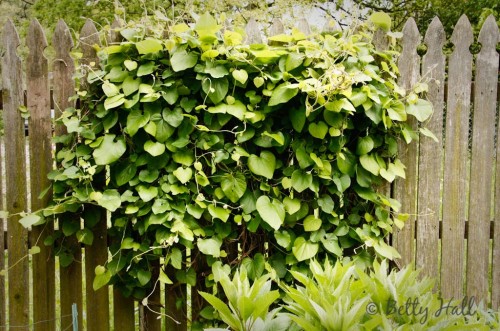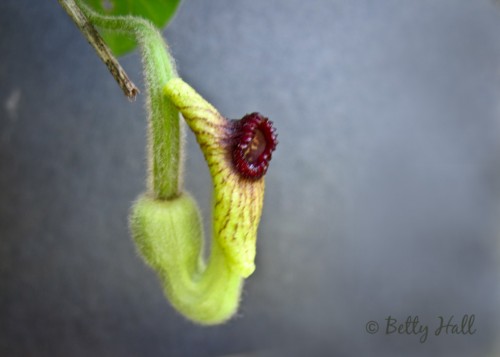Our four-year-old pipevine (Aristolochia tomentosa) is now covered with heart-shaped leaves. This year for the first time it has flowers. They are inconspicuous, and without prompting from my plant guru, Connie, I likely would have missed them.
 Though not showy, these half-inch flowers are quite distinctive. They somewhat resemble a meerschaum pipe, and the plant is often referred to as Dutchman’s Pipevine.
Though not showy, these half-inch flowers are quite distinctive. They somewhat resemble a meerschaum pipe, and the plant is often referred to as Dutchman’s Pipevine.
 The unusual flowers also have a unique pollination method. Attracted by the strong scent, insects crawl inside the flower and are trapped by hairs inside the tube. When the flowers wither, the insects escape, visit another flower, and pollination is accomplished. Another example of nature’s amazing ways!
The unusual flowers also have a unique pollination method. Attracted by the strong scent, insects crawl inside the flower and are trapped by hairs inside the tube. When the flowers wither, the insects escape, visit another flower, and pollination is accomplished. Another example of nature’s amazing ways!
Pipevine is a hardy plant that does well in sun or shade. I grow it because it’s the only host plant (caterpillar food) for beautiful pipevine swallowtail butterflies (Battus philenor). In other words, without pipevines we won’t have pipevine swallowtail butterflies.
Thanks to this vine, we’ve had these butterflies in the backyard, seen them laying eggs, and found their caterpillars. And the unique flowers add to my enjoyment.


You should charge tuition, Betty. I learn as much from your posts as I do reading Doug Tallamy and Tom Barnes’s books. (If I paid tuition, then you’d probably want to grade my learning, huh?) I purchased and planted an itsy bitsy Dutchman’s Pipe Vine last summer and it currently has one small leaf showing above ground. Cheers,
I fear you give me way too much credit, Steve. I’ve just learned about pipevine pollination. What’s important is your interest in learning regardless of source. Glad to know you have a pipevine. May it grow and feed pipevine caterpillars.
Nice photo! I didn’t know about the hairs in the bloom 🙂
Judy, that’s new information for me, too. Isn’t the whole thing amazing?
Hi Betty, that is very interesting how they get pollinated. I used to have a ‘pet’ Venus flytrap plant and my dad and I had great fun feeding it flies (although even as a little kid I felt bad for the flies!). So it was nice to read that some plants capture insects and let them escape!
Yes, Keli, I like the escape part, too. And I bet the insects like it even better!